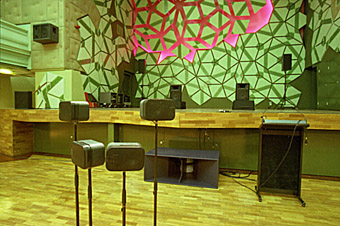An orchestra of speakers
Bruce Mowson: Immersion 2

The Acousmonium, Storey Hall
photo Andrew Curtis
The Acousmonium, Storey Hall
Listening to electroacoustic music can be tough. Despite hours of practicing seated spectatorship, the prospect of remaining focused through 2 hours of electronic music is daunting. Immersed in mediated sound, we are a silenced society of listeners, and have been since the speaker displaced the piano over 100 years ago. Babies are LOUD, and have no understanding of socially encoded silence. When we get drunk, our gag is loosened, and we can become noisy. Mostly though, westerners are lumpen flesh antennas, receiving spectacle from a posterior position and any urges toward communal sound production and participation are lost in a sea of star-envy and self-consciousness.
Electroacoustic music usually has no performer, no entertaining beat and no memorable melody. There are no iconic human forms to focus on, no dancers or dancing, and no bar. Daniel Turrugi, head of the French electronic music institute GRM who came from France to present parts of Immersion 2, readily admitted that it can be hard to concentrate in this type of sonic environment. The French have thought long and hard about issues of presentation in electronic music. Also, they have not flinched from bringing the sound engineer to the foreground and exploring their role as artists. In the 70s, they decided to challenge the orchestral establishment on its own turf (any challengers to the Melbourne Symphony at the Concert Hall?). They invented the Acousmonium, an orchestra of 24-60 speakers arranged around and within the audience, and through regular concerts trained people in moving music in space.
Immersion 2 featured 3 evening concerts: French Historical, Contemporary European and Contemporary Australian, and a 3-hour workshop. The French programs and workshop were presented and curated by Turrugi. Performing live spatialisations for 8 of the 11 French pieces, he demonstrated the richness and spontaneity possible using the speaker orchestra. His skill is the outcome of France’s commitment to research and facilitation of this form; conversely some spatialisation by Australians, such as at Sonic Residues 02, demonstrated the corresponding lack of support here.
The performative aspect of spatialisation became apparent across the 3 concerts. During the first evening, the dynamic movement increased with each of the 6 pieces, as if Turrugi was warming to the system. Any hesitation disappeared when performing his own composition, Mano a Mano, as the piece began by being mixed entirely behind the audience. The second work, La roue Ferris, a masterpiece by Bernard Parmegiani, was a favourite of many in the audience. Following this was François Bayle’s Troupe dans le ciel (1979), a 22-minute epic which used 2 two-note molecules for its construction; it evoked geometric architectural structures such as the geodesic dome. Though the novelty of glitches has well and truly worn off, their appearance in the final piece for the night, Christian Zanesi’s Archeion: Les Mots de Pierre Schaeffer, showed that at least one French Electroacoust ician listens beyond the repertoire.
The second evening program, Contemporary European, contained 5 works by 4 composers, of which 3 were premixed onto 8-track tape. While allowing composition for 8 speakers, these tape works lacked the dynamics of those in which the spatialisation was conceived and performed live by Turrugi in the space. This program tended toward the current trend in French Electroacoustic music, and was characterised by bombastic sprays of dry sound objects. One piece was described as “minimal and noisy” as if it were a daring derivation, yet fans of minimal noise would have had a hard time getting satisfaction from it.
The final program of Contemporary Australian work began strongly with Carpark and Incidentals by Carl Priestly, the spatialisation of which showed off the site-specific re-designing Priestly had done in the rehearsal period. The piece realised the evocative potential of spatial movement as an element of composition, and at only 8 minutes duration, left me wanting more. Darrin Verhagen presented 3 short pieces, the second of which licking the rope burns of the muse stood out for its musical effects—at Immersion 2 the convention of music with sound effects was reversed. Philip Samartzis’ sound for Storey, a collaboration with video artist Dominic Redfern, included layers of texture which, when mixed in space, sounded as if the hall’s vertical surfaces were hung with sound-sheets. Samartzis’ sound came from a stereo source, and was mixed live around the speaker system, demonstrating the advantages of designing the spatialisation at the site. Some of the other works on the night lacked this dimension and a few suffered from being drenched in reverb, which served to wash out their spatial dynamics. In fact, the repeated use of abstracted pianos with reverb detracted from the program as did the bombastic theme of the European program.
Hearing the Acousmonium in the flesh was irreplaceable for experiencing the material possibilities of spatialisation. So too was Turrugi’s workshop, which addressed issues of presentation of electronic music thoroughly researched by the French, such as expanding audiences by doing as much as possible to make this often difficult form accessible. While it would be a mistake to consider the GRM the last word in electroacoustic music, it seems a waste that their research is not more widely known or experienced.
Immersion 2, coordinated & presented by sound artist/academic Philip Samartzis, RMIT Storey Hall, Melbourne, September 7-9
RealTime issue #45 Oct-Nov 2001 pg. 33






